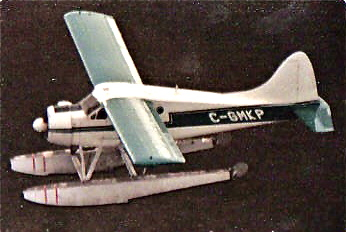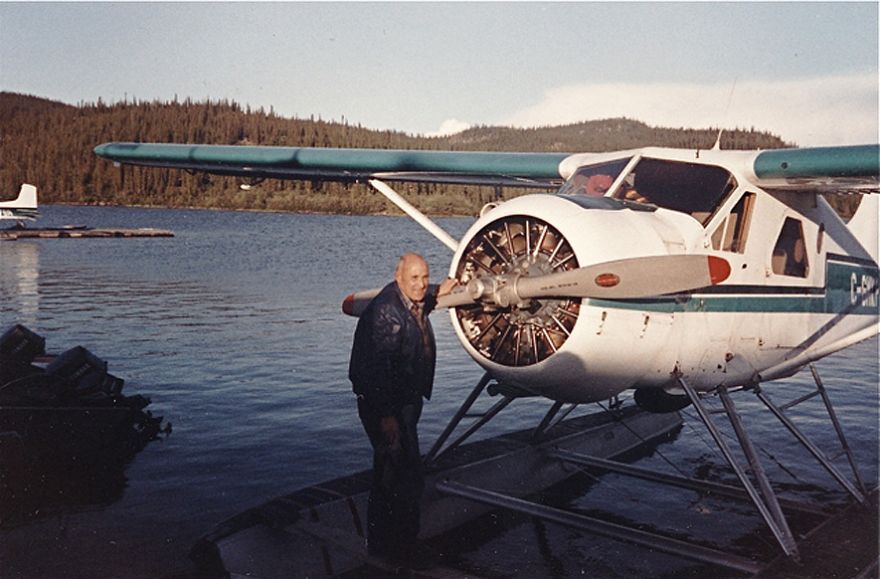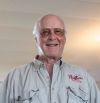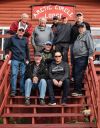Hartley Marsh - Bush Pilot
![]() Written by
Harold
Written by
Harold
- Published in The People
- Read 5510 times
- font size decrease font size increase font size
I first met Hartley Marsh during my initial trip to Branson’s Lodge in the late 1970’s.
As we stepped off the North Cariboo Convair that had just touched down on the gravel strip at Port Radium, lodge owner Ernie Dolinsky told us to head on down to the small lake at the bottom of the runway where several float planes were tethered, and grab seat for the short ride over to the lodge.
It just so happened that I slid into the co-pilots seat of Beaver C-GMKP, which was being piloted by Hartley Marsh. The five - minute flight was as smooth as could be, and before I knew it we were taxiing up to the main dock.
I didn’t even feel the floats touch the water.
Hartley, who hailed from Smith Falls, Ontario, had already logged over 11,000 miles, with over 3,000 of them flown throughout the Arctic.
Graduating from the Bradley Flying School near Ottawa, Ontario in 1949, his first “real” flying job was with a charter company in 1950, following which he spent the next twenty years or so flying in northern Quebec and Ontario. He even flew helicopters in Newfoundland for a period of time.
Despite the fact that I Iogged quite a few hours with Hartley over the next several years, many of which were spent sitting in the seat right next to him, he was not what you would call a talkative man.
As a matter of fact he had a reputation for being somewhat aloof and crusty, and for the most part was all business when behind the controls, and therefore didn’t have the time, or for that matter the inclination, to engage in idle chitchat while he was working.
That said, once back at the lodge, and after he was finished flying for the day, if you pressed him a little he would sometimes give you a glimpse into what it was like to fly bush planes in one of the most remote, and inhospitable places on the planet.
While many of us had this “romantic” notion that being a bush pilot meant days filled with thrills, fun and adventure, Hartley soon set us straight.
Simply put, being a bush pilot was damn hard work, and not without its challenges and dangers.
Long work days, loading and unloading heavy, unwieldy cargo, being away from family and friends for extended periods, and at times flying in extreme, and constantly changing weather conditions with nothing more than a compass and your experience to guide you, were just a few of the challenges bush pilots faced on a regular basis.
To help deal with the rigours of loading and unloading his aircraft with fuel drums and other supplies, he ascribed to the theory – as I suspect most bush pilots do - that the more you swore at a heavy object, the lighter it would become, so in Hartley’s case, all of the stuff he personally loaded must have been as light as a feather.
Hartley was very well acquainted with the dangers of flying in the far north, as this December 9, 1959 article that appeared in the Ottawa Citizen will attest to: click here
This likely explains why he walked with a noticeable limp.
I can recall him saying during one of these evening conversations, that while he loved to fly, and didn’t mind the hard work, the biggest pain in his backside was - at this point he paused, and you could see the trace of a smile forming around the edges of his mouth - having to fly the likes of us all over “hells half acre.”
During our first trip to Great Bear, a few of us came up with the bright idea that because he had been flying across the length and breadth of the lake for years, Hartley would have the inside track on where all the really big fish were, and we made the mistake of peppering him with all manner of questions about where to fish, what kind of lures to use etc.
We were told in no uncertain terms that he personally didn’t like to fish, couldn’t understand why people would pay all that money, and come all this way just to fish – and no – he didn’t know, or for that matter particularly care, where the big fish might be.
One of my fondest memories involving Hartley was an incident that occurred during my third year at Branson’s.
As we climbed into Hartley’s Beaver in preparation to being shuttled over to the lodge, it was obvious he was not in his usual “jovial” mood. Once we were all buckled in, it became very clear what was stuck in his craw when he informed us that:
“The goddamn Canadian Aviation Authority, or whatever they call themselves, has been poking around, and told us that, along with a bunch of other crap, we have to give our passengers a safety briefing before take off.”

Knowing Hartley, and given his obviously strong opinions on the matter, it was very clear to most of us that we were unlikely to get much, if anything in the way of a briefing, but one unsuspecting “rookie” in the back of the airplane, who didn’t know any better, ventured to ask when he could expect to be briefed.
Turning around in his seat, and pinning the guy with a look that was designed to, and succeeded in conveying as much contempt as possible, Hartley said something along these lines:
“So you want to be briefed do you?
Well, let me tell you son, this airplane has four exit doors, and if you haven’t figured out where they are by now, God help you.
If for some reason we start to go down, and if you can find the room and the time, put your head between your legs and kiss your ass good bye, and just in case you were wondering, the emergency locator beacon and first aide kit is somewhere back of where your sitting.
So, do you want me to talk or fly?”
Needless to say, despite the fact that everyone was really hyped about being back at Bear, our normally animated conversation was put on hold, and you could have heard a pin drop during the flight over to the lodge.
While the vast majority of my flying time with Hartley was pretty much routine, there was one particular flight where I witnessed first hand his truly unflappable demeanour and skill as a pilot.
Branson’s offered a fly out to fish for Arctic Char on the Kugaryak River, which was about 175 air miles north east of the lodge. The two - hour flight would take us over a portion of the Arctic “barren lands,” and across the Coppermine River and Coppermine mountain range.
Before heading out, a call was made to the weather station in the village of Coppermine (now Kugluktuk) to check the weather conditions on the Arctic coast. Apparently the weather was fine, so Hartley loaded our gear, and together with Ernie, we piled into C-GMKP.
As we approached the Coppermine Mountains – in actual fact we had to take Hartley’s word for it that they were out there somewhere - the only thing we could see was a wall of thick fog.
After flying along the edge of the fog for several minutes, he began probing in an attempt to see just how thick and far ranging it actually was.
Seeing the concerned look on our faces when he turned the Beaver directly into the fog, thereby completely wiping out what little visibility there was, Ernie told us not to worry because we were flying two or three hundred feet above the highest point of the range, and to emphasize his point tapped the altimeter with his finger just to demonstrate that it was not stuck on a lower reading, and otherwise functioning properly.
It was one of the few times that I saw something that may have actually been a grin on Hartley’s face.
After making several attempts, Hartley concluded that it was unlikely we could punch through, so he turned towards home, only to find that the fog had now completely encircled us.
Without missing a beat, he gently banked C-GMKP, and began a slow, winding descent, with each of us silently hoping that the mountains were well behind us. In no time at all, we broke through the fog, and found ourselves several hundred feet directly above the Coppermine River.
He then radioed "Kug", and was told that a massive bank of fog had, without warning, blown inland off of the Arctic Ocean, making it virtually impossible to fly back to the lodge.
According to Ernie, given the unpredictability of Arctic weather, this type of thing was not unusual – weather reports notwithstanding – our only option was to follow the river downstream to "Kug", where we would wait until things cleared up, and if need be, stay the night.
While it may have been just another day at the office for Hartley, in my view this was a spectacular piece of flying and navigation, and other than being a bit concerned when we first flew into the fog, I quickly came to realize that we were in the best possible hands, and sat back and enjoyed the flight from that point onwards.
Hartley was one of an ever-diminishing number of bush pilots, who were the men that actually helped to open up the most remote northern recesses of this continent.
Long before the advent of GPS, reliable radio communication and other modern navigational aides, these aviation pioneers often times piloted their aircraft relying solely on memory, instinct, steady nerves and raw courage to ensure that both cargo and passengers arrived at their destination safely.
Hartley was in his early-fifties when I first flew with him, so he would now be in his early eighties.
Hopefully he is doing well, and I count myself among the lucky ones to have had the privilege to fly with one of the very best.
Post Scrip:
Remarkably, Hartley's beloved C- GMKP is still flying.
As of 2016, and having undergone a number of modifications since first commissioned in 1953, she is currently being operated by Harbour Air Seaplanes in British Columbia.
If you would like to see some images of her over the years, click on:
http://www.dhc-2.com/id232.htm
PPS - Sadly, on June 23, 2019, Hartley passed away at 90 years young.






